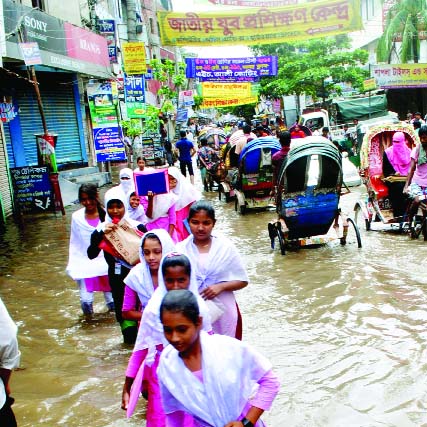
Staff Reporter :The waters continue to rise in all the major rivers except Ganges, worsening the flood situation further in different parts of the country, including Dhaka. Alongside with the flood, the river erosion is also devouring some areas, including Sirajganj, Madaripur and Gaibandha.According to the Flood Forecasting and Warning Centre (FFWC), the water at least at 19 points was flowing above the danger levels on Thursday. The Dharla River was flowing above 43 cm of the danger level in Kurigram, while 10 cm in Teesta River at Dalia point, 50 cm in Gaghat River in Gaibandha, 40 cm in Brahmmaputra River at Chilmari, 74 cm in Jamuna River in Sariakandi, 24 cm in the river in Sirajganj, 85 cm in Atrai River, 72 cm in Dhalashweri River, 17 cm in Padma River in Goalanda point, 27 cm in Surma River in Sunamganj and 10 cm in Kushiyara River in Sherpur. The flood situation in at least 14 districts may further deteriorate in next 48 hours. The districts are Lalmonirhat, Kurigram, Nilphamari, Rangpur, Gaibandha, Bogra, Sirajganj, Jamalpur, Tangail, Shariatpur, Madaripur, Munshiganj, Rajbari and Faridpur. It may improve in three districts- Netrokona, Sunamganj and Sylhet, said Ripon Karmaker, Assistant Engineer of the FFWC.According the FFWC, the water of the rivers- Buriganga, Balu, Turag and Turag Khal- may likely to rise in next 72 hours. The flood water have already entered some low-lying areas in and around the capital city and it was being increased. Particularity, the people of the surrounding areas of the city are already facing miseries due to the flood. The water in the Shitalakkhya River in Narayanganj was flowing above 20 cm of danger mark on Thursday. The water in the Buriganga River was also rising. Vast parts of the low-lying areas of the Dhaka city on the banks of the two rivers have already been inundated. If the flood water rises further, people living in the areas, including Kashipur and Alirtek, will be displaced from their homes. Aman paddy and other crops of the areas are already being affected seriously, said the locals. In Kurigram, about 2.5 lakh people of at least 300 villages under 57 unions in the district are still marooned. However, the flood victims took shelter on road side, high lands as well as embankments with their belongings, poultry birds and domestic animals. About three hundred fish projects flashed away. Over two hundred educational institutions remained closed, as the flood water inundated the rooms of the institutions. The road communications in several parts of the district broke down, as a number of roads went under flood water. The people of the affected areas now rely on boat and other temporary vehicles run on waterway. In this situation, the people of the district are passing their days miserably. Particularly the people of Chimari, Raumari, Rajibpur, Ulipur, Nageshwari and Kurigram Sadar upazilas were affected dangerously. At least 35 thousand hectares of land of Aman paddy and several other seasonal crops were damaged due the flood which has been continuing for two weeks. The flood victim people are facing extreme difficulties due to shortage of dry food and pure drinking water. Alongside with the shortage, different water-borne diseases are also spreading in the flood affected areas. The activities of the Health Department were not seen till now in this regard. In Gaibandha, the overall flood situation in chars and the Brahmmaputra River basin of the district deteriorated further due to the rise of water level in the river. The flood water inundated more fresh areas also on Thursday. Over one lakh people were marooned in Kapasia and Chandipur unions of Sundarganj upazila, Kamarjani and Mollarchar unions of Sadar upazila, Fazlupur, Erendabari, Gozaria, Fulchhari and Urya unions of Fulchhari upazila and Holdia and Saghata unions of Saghata upazila.As a result, the standing crops particularly Aman seed bed, Aus variety, T-Aman paddy and seedbed of late variety Ganzia paddy including summer vegetables went under flood water making the farmers worried and frustrated about their food security. Deputy Director of the Department of Agriculture Extension Mir Abdur Razzak said that as many as 3079 hectares of crop land in 29 unions in four upazilas went under flood water but the quantity of losses caused by flood could not be ascertained immediately.Many flood victims took shelter on the nearby flood control embankment and were passing their days miserably with their belongings including domestic animals and poultry birds. They are facing crisis of relief materials. Although the local administration distributed relief materials among the flood affected people, these were insufficient against the needs. Deputy Commissioner (DC) of Gaibandha Md Ehsan-e-Elahi said that the government had allocated a total of 500 tonnes of rice and Tk 11 lakh for distribution among the flood victims of the upazilas. Of them, some 298 tonnes of rice and Tk more than 5.83 lakh had already been disbursed to the flood victims here till August 27, he also said.In Munshiganj, water in the Padma River was rising and for this reason, fresh areas of Srinagar, Lauhajang, Tongibari and Munshiganj Sadar upazilas went under flood water. The low-lying areas of the upazilas have been flooded. Many people have been marooned while the flood affected people are now facing crisis of dry food and pure drinking water.In Faridpur, Deputy Commissioner Sharafat Ali, Police Super M Jamil Hassan, Sadar Upazilla chairman Kh. Mohtesham Hossain Babor, UNO of Sadar Upazila Jahirul Islam and UP chairman Sadikuzzaman Milon Pal on Thursday distributed rice among the affected families under Decreer Char union of Sadar upazilla. Sharafat Ali said relief work would continue till the water completely recedes from the submerged areas and then the rehabilitation process would start.

